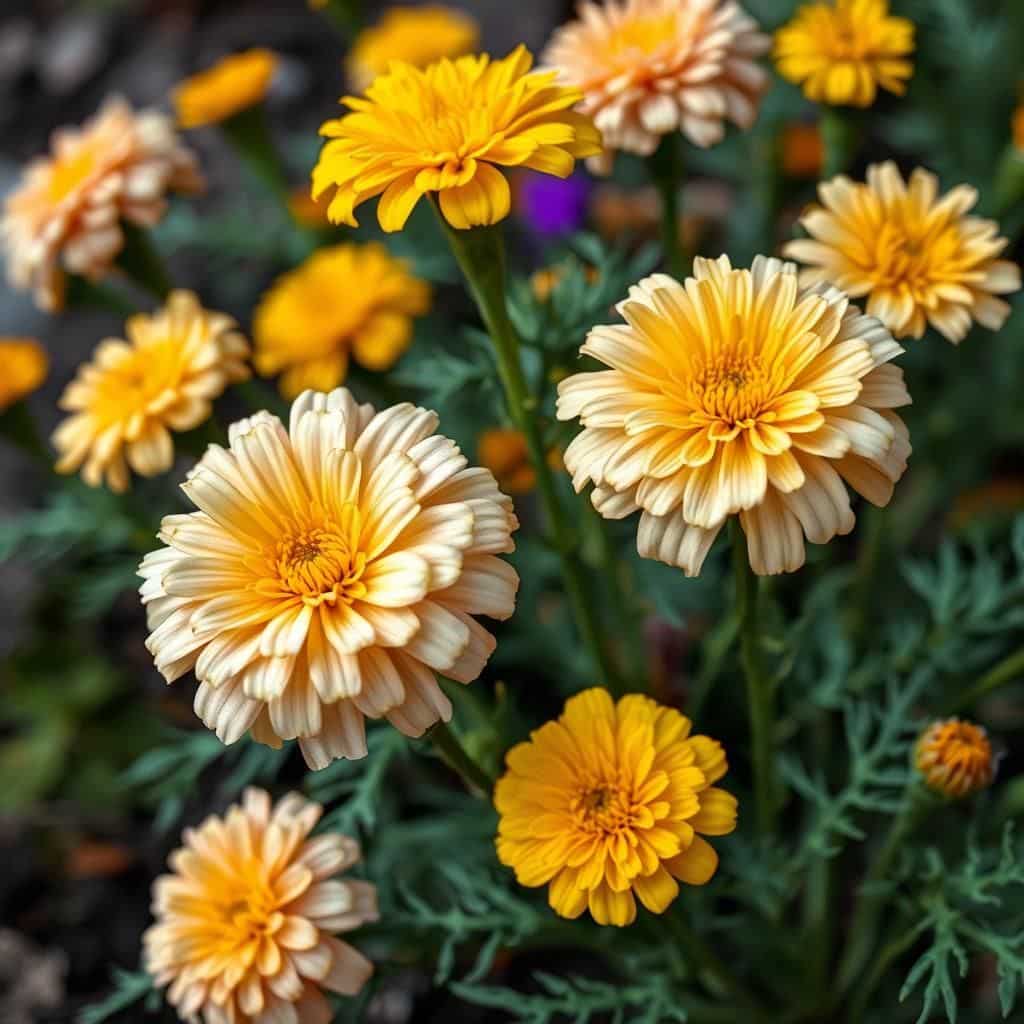Are Marigolds a Hardy Annual? Discover the Truth About This Resilient Flower

Marigolds, with their vibrant hues and charming blooms, have long been a favorite among gardeners. However, there's often confusion regarding their classification as hardy annuals. As we delve into the characteristics of these resilient flowers, we will explore what makes marigolds a popular choice for gardens worldwide. From their ability to withstand various weather conditions to their role in pest management, understanding whether they truly qualify as hardy annuals can aid gardeners in making informed choices. Join us as we uncover the truth behind marigolds and their remarkable resilience in the ever-changing gardening landscape.
Are Marigolds Hardy Annuals?
Marigolds are commonly regarded as hardy annuals, meaning they complete their life cycle within one growing season and can withstand cooler temperatures. They are particularly well-known for their vibrant colors and ease of growth, making them a favorite among gardeners. Hardy annuals like marigolds can be sown directly into the garden once the threat of frost has passed, but they can also tolerate light frosts, which extends their blooming season. Due to their resilience and adaptability, marigolds thrive in various soil conditions and can flourish in full sun or partial shade, enhancing their appeal for gardeners looking for low-maintenance yet beautiful plants.
Characteristics of Hardy Annuals
Hardy annuals, including marigolds, are characterized by their ability to germinate, grow, flower, and set seeds within a single growing season. They can establish themselves quickly and are often sex-reproductive in just a few months. These plants are typically robust enough to survive light frosts, allowing them to be planted early in the spring and enjoyed throughout the summer and into the fall. This rapid growth cycle makes them highly desirable for gardeners seeking instant color in their landscapes.
Growing Conditions for Marigolds
Marigolds thrive best in full sunlight but can adapt to partial shade. They prefer well-draining soil that is rich in organic matter, which promotes healthy growth and blooming. Adequate watering is also crucial; however, it is important to avoid waterlogged conditions, as this can lead to root rot. Soil with a pH level between 6.0 and 7.0 is ideal for marigolds, enabling them to develop strong root systems and vibrant blooms, making them a fantastic option for various garden settings.
Pest and Disease Resistance
One of the advantages of planting marigolds is their natural pest deterrent qualities. They are known to repel certain insects, such as aphids and nematodes, which can harm other plants in the garden. Additionally, marigolds are less susceptible to diseases compared to some other annual flowers, making them a resilient choice for gardeners. Implementing marigolds in companion planting can help protect more vulnerable plants, benefiting the overall health of the garden ecosystem.
See also:
Uses of Marigolds in Gardening
Marigolds serve numerous purposes in gardens and landscapes, offering both aesthetic and practical benefits. They are often planted as border plants, in containers, or as filler plants due to their bushy growth and vibrant colors. Moreover, their ability to deter pests makes them ideal companions for vegetables and other flowers, enhancing biodiversity within the garden. Marigolds can also be used for cut flower arrangements, bringing their bright hues indoors.
Caring for Marigolds Throughout the Season
Caring for marigolds involves regular watering, especially during dry spells, and deadheading spent flowers to encourage extended blooming. Fertilizing with a balanced, all-purpose fertilizer can enhance growth and flower production, though marigolds typically do not require heavy feeding. Additionally, monitoring for pest issues and promptly removing any affected plants can help maintain a healthy garden. With proper care, marigolds can bloom profusely from spring until the first frost.
| Aspect | Details |
|---|---|
| Type | Hardy Annual |
| Sunlight | Full Sun to Partial Shade |
| Soil | Well-draining, Rich in Organic Matter |
| Frost Tolerance | Can withstand light frosts |
| Pest Resistance | Natural deterrent for certain insects |
Understanding the Hardiness of Marigolds
Marigolds, known for their vibrant colors and ability to thrive in various environmental conditions, are often classified as hardy annuals. This classification stems from their resilience to frost and cold temperatures, allowing them to survive and bloom early in the growing season. They can withstand chilling nights and, in many regions, may even self-seed, contributing to their status as persistent garden favorites. Their adaptability to different soil types and overall low maintenance requirements further emphasizes their hardy nature, making marigolds a popular choice for both novice and experienced gardeners.
What Are Hardy Annuals?
Hardy annuals are plants that can survive colder temperatures, generally sprouting in spring and blooming throughout the summer. Unlike tender annuals, which cannot resist frost, hardy annuals possess an inherent tolerance to chill, enabling them to thrive even when temperatures dip. This quality allows gardeners to sow seeds earlier in the year, extend their growing season, and enjoy continuous blooms. Such plants often include varieties like pansies, snapdragons, and, importantly, marigolds, which can supplement any garden with their lively presence.
Characteristics of Marigolds
Marigolds are characterized by their vibrant colors, with blooms typically ranging from yellow to orange and various shades in between. Their flowers have a unique structure, often resembling daisy-like formations that add a striking contrast to garden landscapes. The plants are also known for their aromatic foliage, which can deter pests and attract beneficial insects, making them a staple in companion planting. Moreover, marigolds display remarkable endurance against unideal conditions, showcasing their hardiness and adaptability.
See also:
Growing Conditions for Marigolds
Marigolds thrive in full sunlight and flourish in well-drained soil, although they can tolerate a range of conditions. They prefer soil that is rich in organic matter, which supports their growth and blooming potential. While they are drought-tolerant once established, they require regular watering during dry spells to produce optimal blooms. Their ability to adapt to different soil types and varying moisture levels underscores why marigolds can be classified as hardy annuals.
Benefits of Growing Marigolds
Growing marigolds offers a multitude of benefits. One of their key advantages is their ability to repel pests, such as aphids and nematodes, thereby safeguarding other plants within the garden. Beyond pest management, marigolds bring aesthetic beauty to the landscape, enriching it with their vibrant blooms. Additionally, their self-seeding nature makes them a sustainable choice, capable of reappearing each year with minimal intervention. These attributes collectively highlight the value of marigolds in both ornamental and functional gardening.
Common Pests and Diseases in Marigolds
While marigolds are generally resilient, they can be susceptible to several pests and diseases. Common issues include aphids, which can inhibit plant growth by sucking sap, and whiteflies, which can lead to yellowing leaves. Additionally, marigolds can experience root rot if exposed to excessive moisture or poorly drained soils. Recognizing these potential threats allows gardeners to implement adequate pest control measures and ensure the enduring vitality of their marigold plants.
Questions from Our Readers
Are marigolds considered hardy annuals?
Marigolds are typically classified as hardy annuals, which means they can withstand cooler temperatures and often thrive in early spring. This classification allows them to be planted early in the season in many regions, as they can tolerate light frost.
What conditions do marigolds need to thrive?
Marigolds prefer full sun and well-drained soil for optimal growth. They thrive in warm conditions but are also quite resilient, making them suitable for various garden environments.
See also:
Can marigolds survive frost?
While marigolds are considered hardy, they can only tolerate light frost. Prolonged exposure to heavy frost can damage the plant, so it's best to protect them or cover them during unexpected cold snaps.
How do marigolds benefit a garden?
Marigolds are known for their pest-repelling properties, particularly against nematodes and certain insects. Planting marigolds in your garden can enhance the health of surrounding plants by naturally deterring pests.

If you want to read more articles like Are Marigolds a Hardy Annual? Discover the Truth About This Resilient Flower, we recommend you check out our Flowers category.
Leave a Reply
Related Articles